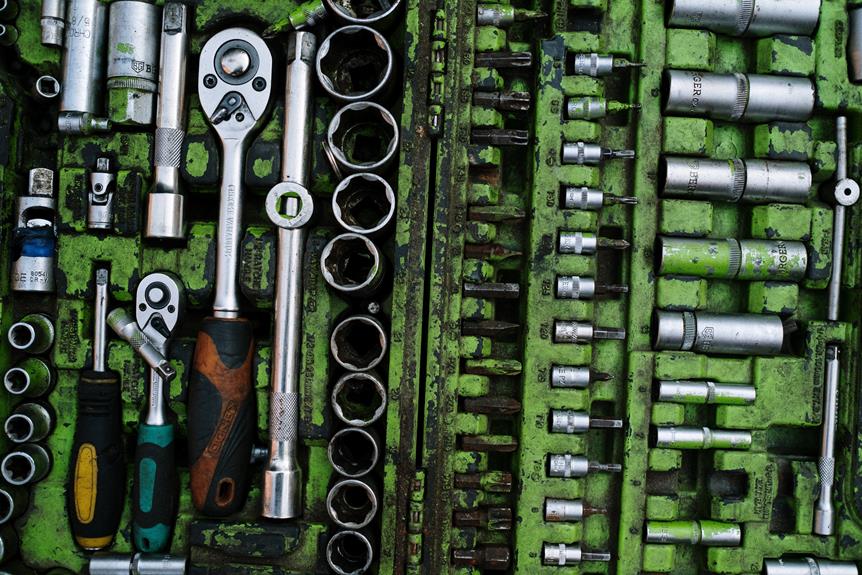Tire Storage Tips: Keeping Your Spare in Shape
Are you tired of being stranded on the side of the road with a flat tire and no spare? Look no further – our tire storage tips will ensure that your spare tire is always in top shape and ready to go.
From choosing the right storage location to regularly checking its condition, we have all the expert advice you need to keep your spare tire in perfect condition.
Say goodbye to roadside emergencies and hello to peace of mind.
Key Takeaways
- Choose a storage location that is clean, dry, and well-ventilated to prevent aging and performance issues.
- Clean and inspect your spare tire regularly to remove dirt and debris, and replace if necessary.
- Properly inflate your spare tire to ensure effectiveness in emergency situations and maximize its lifespan.
- Regularly check and maintain the proper inflation of the spare tire to ensure readiness for use when needed.
Choosing the Right Storage Location
When it comes to choosing the right storage location for your spare tire, it is important to consider factors such as temperature, humidity, and accessibility. Properly storing your spare tire can significantly extend its lifespan and ensure that it is in optimal condition when you need it most.
One option for storing your spare tire is using a protective cover. These covers are designed to shield the tire from dust, dirt, and UV rays, which can cause damage over time. They also help to maintain the tire's integrity by preventing it from drying out or cracking. It is recommended to choose a cover that is specifically designed for spare tires to ensure a proper fit.
Another storage option is a tire rack. This is a convenient and efficient way to store your spare tire, especially if you have limited space. A tire rack allows you to keep the tire off the ground, preventing any potential damage from moisture or pests. It also provides easy accessibility, allowing you to quickly retrieve the spare tire in case of an emergency.
Regardless of the storage location you choose, it is important to ensure that it is clean, dry, and well-ventilated. Avoid storing the tire in areas with extreme temperatures or high humidity, as this can accelerate the aging process and compromise the tire's performance.
Cleaning and Inspecting Your Spare Tire
To properly maintain your spare tire, it is crucial to regularly clean and inspect it for any signs of wear or damage. Cleaning techniques will vary depending on the type of spare tire you have.
There are three main types of spare tires: the full-size spare, the compact spare, and the temporary spare.
For full-size spare tires, the cleaning process is similar to that of regular tires. Begin by rinsing off any dirt or debris with water. Use a mild soap and a soft bristle brush to gently scrub the tire's surface. Rinse thoroughly and allow it to dry completely before storing it. It is important to avoid using harsh chemicals or abrasive materials, as these can damage the tire.
Compact spare tires, also known as 'donuts,' require special care due to their smaller size. Clean them using a sponge or cloth dipped in soapy water. Gently scrub the surface, paying close attention to any dirt or grime buildup. Rinse thoroughly and dry completely before storing.
Temporary spare tires, commonly known as 'mini spares,' are not intended for long-term use or extensive cleaning. These tires are typically used as a temporary solution until a proper tire can be repaired or replaced. To clean a temporary spare, simply wipe it down with a damp cloth to remove any surface dirt.
Regularly inspecting your spare tire is equally as important as cleaning it. Look for signs of wear, such as cracks, bulges, or uneven tread wear. If you notice any damage, it is recommended to replace the tire immediately.
Properly Inflating Your Spare Tire
Properly inflating your spare tire is crucial for ensuring its effectiveness in an emergency situation.
It is recommended to check the optimal spare tire pressure, which is usually indicated in the vehicle's owner's manual or on a sticker located inside the driver's side door jamb.
Regularly checking and maintaining the proper inflation of your spare tire will help maximize its lifespan and ensure that it is ready to be used when needed.
Optimal Spare Tire Pressure
Maintaining the optimal spare tire pressure is crucial for ensuring the reliability and performance of your vehicle's backup tire. Proper tire pressure maintenance not only extends the lifespan of the spare tire but also ensures that it is ready for use in case of an emergency.
When it comes to spare tire storage techniques, it is essential to store the spare tire in a clean and dry environment. Avoid exposure to extreme temperatures, as they can affect the tire's structural integrity. Regularly inspect the spare tire for any signs of damage or wear, such as cracks or bulges, and replace it if necessary.
Additionally, make sure to check the spare tire's pressure periodically and adjust it to the recommended level. By following these tire storage tips, you can ensure that your spare tire is in optimal condition when you need it most.
Importance of Regular Checks
Regular checks are crucial for ensuring the longevity and effectiveness of your vehicle's spare tire and can be achieved by regularly inspecting its pressure and overall condition. Proactive maintenance plays a vital role in keeping your spare tire in optimal shape, offering several benefits. Firstly, regular checks help identify any signs of wear and tear, such as cracks or bulges, which can potentially lead to tire failure on the road. Secondly, maintaining the correct tire pressure ensures proper performance and extends the lifespan of the spare tire. Lastly, regular inspections allow for prompt repairs or replacements, saving you from unexpected breakdowns and costly repairs. By taking the time to check your spare tire regularly, you can ensure that it is ready to be used when needed, providing you with the freedom to travel with peace of mind.
| Importance of Regular Checks | Benefits of Proactive Maintenance |
|---|---|
| Identifies wear and tear | Extends the lifespan of the tire |
| Ensures proper performance | Saves from unexpected breakdowns |
| Allows for prompt repairs | Provides peace of mind |
Protecting Your Spare Tire From the Elements
When storing your spare tire, it is essential to shield it from the damaging effects of the elements, such as rain, sunlight, and extreme temperatures. The spare tire cover plays a crucial role in protecting the spare tire from these elements. It acts as a barrier, preventing direct exposure to rainwater, which can cause corrosion and rust. Moreover, the cover shields the tire from the harmful UV rays of the sun, which can deteriorate the rubber over time. Extreme temperatures, both hot and cold, can also negatively impact the spare tire's integrity, leading to potential failure when needed.
To ensure maximum protection, it is recommended to store the spare tire in the vehicle itself. This not only shields it from the elements but also provides a controlled environment, minimizing the effects of temperature fluctuations. The spare tire should be securely fastened in its designated storage area, preferably in a clean and dry compartment. Additionally, periodically check the spare tire cover for any signs of wear and tear. If necessary, replace the cover to maintain optimal protection for your spare tire.
Rotating Your Spare Tire
When it comes to maintaining your spare tire, rotating it is an essential step.
Rotating your spare tire ensures that all tires on your vehicle wear evenly and last longer.
It's recommended to include your spare tire in your regular tire rotation schedule, typically every 5,000 to 7,000 miles.
Optimal Spare Tire Rotation
To ensure even wear and maximum durability, proper alignment and rotation of your spare tire is essential for optimal performance. Not only does regular rotation help extend the lifespan of your spare tire, but it also provides several other benefits. By rotating your spare tire, you can evenly distribute the wear and tear on all tires, which helps to maintain traction and handling. Additionally, rotating your spare tire allows you to inspect it for any signs of damage or wear, ensuring that it is in good condition and ready to use in case of an emergency. Here is a table summarizing the benefits of spare tire rotation:
| Benefits of Spare Tire Rotation |
|---|
| Even wear distribution |
| Increased traction |
| Improved handling |
| Enhanced safety |
| Early detection of damage |
Tire Maintenance Tips
One important tire maintenance tip is to regularly rotate your spare tire, as it helps to evenly distribute wear and maintain optimal performance.
In addition to spare tire rotation, proper tire storage techniques play a crucial role in extending the lifespan of your spare tire. Here are some tips to ensure your spare tire remains in good condition:
- Store the spare tire in a cool, dry place to prevent cracking and deterioration.
- Keep the spare tire away from direct sunlight, as UV rays can cause rubber to degrade.
- Check the air pressure of the spare tire periodically to ensure it is properly inflated.
- Inspect the spare tire for any signs of damage or wear, such as cuts, bulges, or uneven tread wear.
- Rotate the spare tire with the other tires on a regular basis to evenly distribute wear and extend its lifespan.
Regularly Checking the Condition of Your Spare Tire
Regularly, it is imperative to thoroughly inspect the condition of your spare tire to ensure its reliability in times of emergency. Checking the spare tire pressure and maintaining its quality are essential for a safe and smooth journey. When it comes to spare tire maintenance, there are a few key factors to consider.
Firstly, you should regularly check the spare tire pressure to ensure it is inflated to the recommended level. This can be done using a tire pressure gauge, which is easily available at most automotive stores. Keeping the spare tire properly inflated ensures that it is ready for use when needed, as underinflated tires can affect your vehicle's handling and fuel efficiency.
In addition to checking the tire pressure, it is crucial to inspect the overall condition of the spare tire. Look for any signs of damage, such as cuts, bulges, or sidewall cracks. If you notice any of these issues, it is advisable to replace the spare tire immediately, as a damaged tire may not be able to provide the necessary support in an emergency situation.
Furthermore, it is important to keep the spare tire clean and protected from the elements. Store it in a cool and dry location away from direct sunlight and extreme temperatures. Regularly clean the tire using mild soap and water to remove any dirt or debris that may have accumulated.
Frequently Asked Questions
How Often Should I Rotate My Spare Tire?
It is recommended to rotate your spare tire every 6,000-8,000 miles or as specified by your vehicle manufacturer. Properly inflating your spare tire and regularly checking for signs of wear are crucial for its longevity and effectiveness.
Can I Store My Spare Tire in a Basement or Garage?
Storing your spare tire in a basement or garage can have several benefits. It protects the tire from harsh weather conditions, reduces the risk of damage or theft, and ensures easy accessibility when needed.
What Should I Do if My Spare Tire Is Not Properly Inflated?
If your spare tire is not properly inflated, it is important to address the issue promptly. Start by checking the tire pressure using a gauge and add air if necessary. Look for signs of a deflated spare tire, such as sagging or flat appearance.
Is It Necessary to Clean My Spare Tire Before Storing It?
Cleaning your spare tire before storing it is not necessary, but it has several benefits. It helps remove dirt and debris, prevents corrosion, and ensures better longevity. Proper storing techniques, such as keeping it in a cool and dry place, are also essential.
How Long Can a Spare Tire Be Stored Before It Becomes Unusable?
The lifespan of a stored spare tire depends on various factors such as storage conditions and tire quality. Properly storing spare tires in a clean and dry environment can help prolong their usability and ensure their safety when needed.
Conclusion
To ensure your spare tire is in optimal condition when you need it most, proper storage and maintenance are key. By choosing a suitable storage location, cleaning and inspecting the tire regularly, and protecting it from the elements, you can extend its lifespan.
Remember to rotate the spare tire periodically and regularly check its condition to avoid any unpleasant surprises.
Just like a well-maintained spare tire, being prepared for unexpected situations in life can save you from unnecessary stress and inconvenience.







